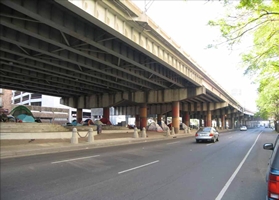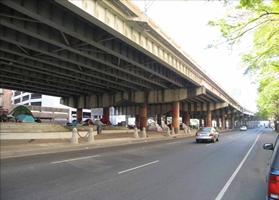It’s one thing to talk about designing cities and towns for people instead of cars, as Transportation Secretary Ray LaHood has done.
It’s another thing to make good on that pledge by tearing down elevated highways that prevent foot traffic and isolate neighborhoods from each other. LaHood’s Transportation Department announced support for three such projects in a major funding announcement Wednesday. The department made $600 million in TIGER II grants, funding 42 construction projects and 33 planning projects around the country.
Perhaps the most eye-catching winner is the New Haven, Conn., Downtown Crossing, which gets $16 million to remove the limited-access Route 34. Residents and planners hate how it blocks foot-traffic and streetfront retail and separates the city’s Union Station and the Yale-New Haven hospital complex from the rest of downtown. Now it’ll be replaced with two walk-bike-transit-friendly boulevards
“We think this is a big f—ing deal,” New Haven Mayor John DeStefano Jr. said.
 The Claiborne Expressway in New OrleansPhoto: Congress for the New UrbanismHighway tear-down projects for the Claiborne Corridor in New Orleans and the Sheridan Expressway Corridor New York also received funding for planning, although they aren’t yet a certainty.
The Claiborne Expressway in New OrleansPhoto: Congress for the New UrbanismHighway tear-down projects for the Claiborne Corridor in New Orleans and the Sheridan Expressway Corridor New York also received funding for planning, although they aren’t yet a certainty.
Announcing new projects is politically easier than getting rid of harmful ones, so the tear-downs signal a commitment to ending the federal government’s history of auto-only transportation funding. It doesn’t hurt that aging elevated highways are uniquely expensive to maintain.
The rest of the TIGER II projects reveal the administration’s priorities too. There’s a focus on small-scale projects in small and mid-size cities, as Transport Politic notes — things like transit centers, street improvements, and rehabbing freight rail lines. (The previous round of TIGER grants focused on larger cities). But there is also funding for a light-rail line in Los Angeles, a streetcar line in Atlanta, and a streetcar line in Salt Lake City. $140 million goes to rural projects.
Broken down by mode, roughly 29 percent of the money goes for road projects, 26 percent for transit, 20 percent for rail projects, 16 percent for ports, 4 percent for bicycle and pedestrian projects and 5 percent for planning projects, according to the DOT. (So roads aren’t really getting the shaft.)
In case you’re wondering, the funding comes from the 2010 general appropriation bill, not the stimulus act. The DOT said it gave priority to projects that can quickly create jobs.




